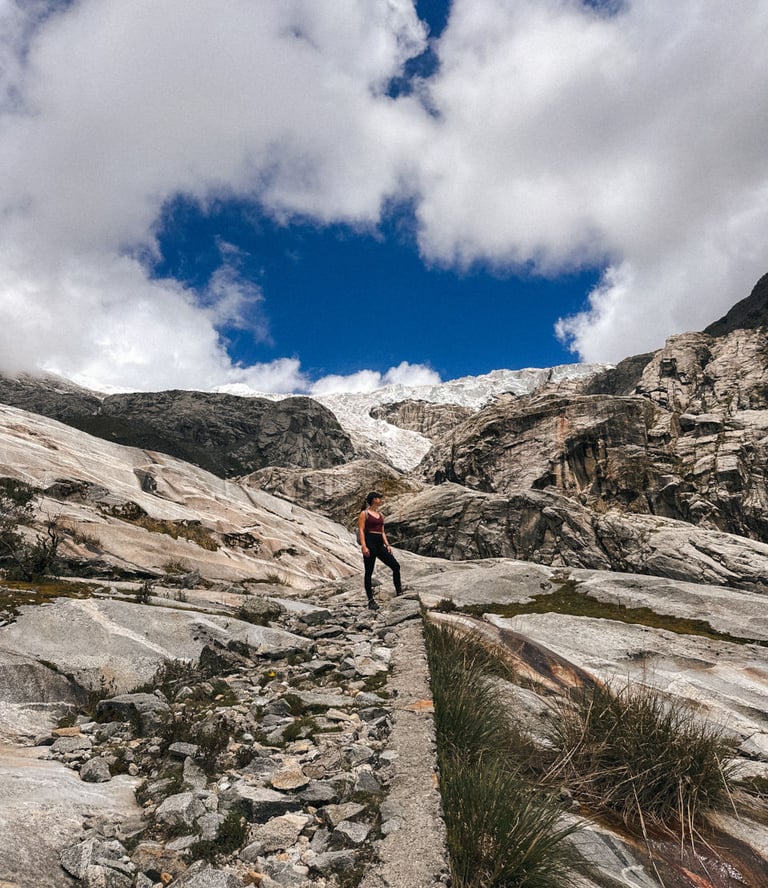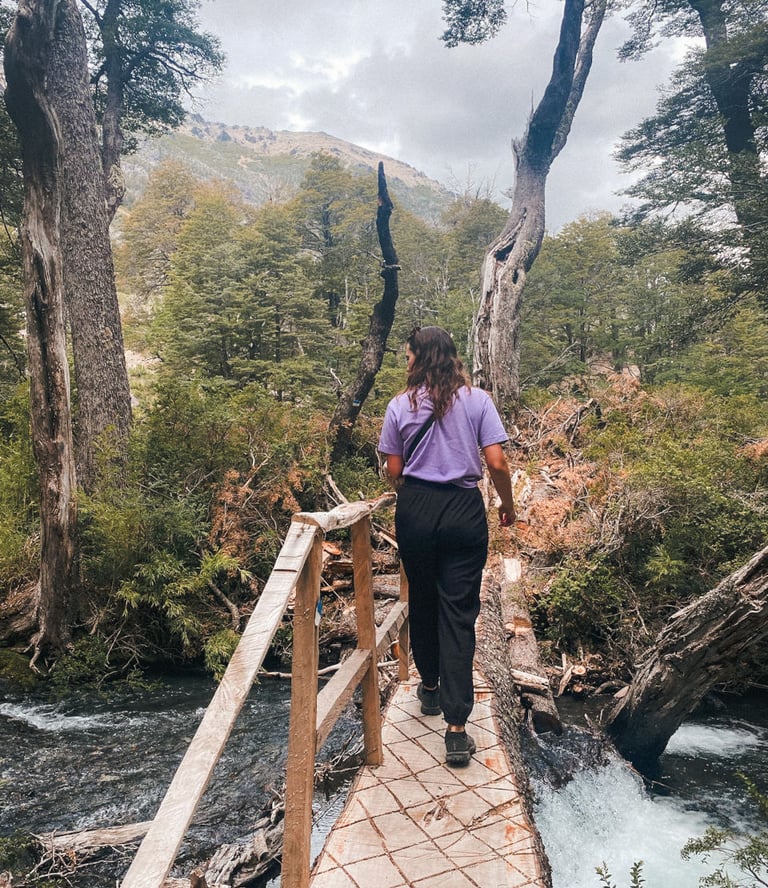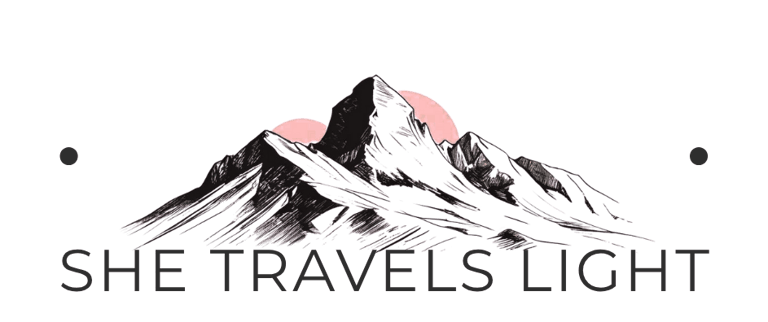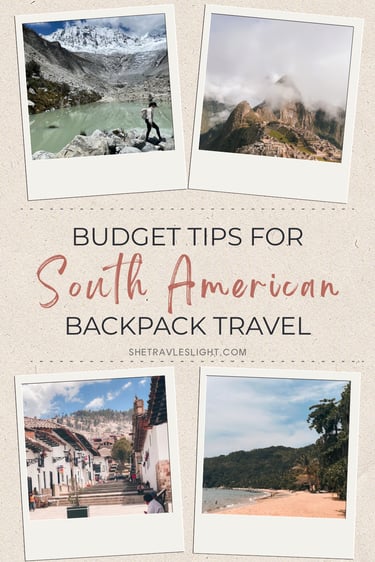The Ultimate Packing List for Women Backpacking South America
From freezing mountains to tropical rainforests - packing for six months across eight South American countries in a 40L backpack means choosing wisely. This guide for women shares the real must-haves, what not to bring, and how to travel lighter.
Sasha Hjort
5/8/20248 min read
The Ultimate Packing List for Women Backpacking South America
From freezing mountains to tropical rainforests - packing for six months across eight South American countries in a 40L backpack means choosing wisely. This guide for women shares the real must-haves, what not to bring, and how to travel lighter.
24/8/2025 • 7 min read





Packing for South America as a woman can feel like prepping for four seasons in one backpack. That’s exactly what I did before spending six months zig-zagging across the continent - from the humid Amazon to the freezing Andes, beach towns in Brazil to the high-altitude of La Paz.
Whether you’re planning a 2-week trip or a 6-month adventure, this guide will help you pack light, stay comfortable, and avoid the dreaded “I brought way too much” meltdown.
And spoiler alert: you don’t need as much as you think. But you do need to pack smart.
Table of Contents
Click on the topic of interest for faster navigation:
My Full Backpacking Packing List (the exact items)
Here’s exactly what I packed in my main backpack, daypack, toiletry kit, cable organizer, and crossbody bag for a six-month trip across 8 countries. Some things I used every single day. Others? I probably could’ve left at home. I’ll let you decide what’s essential for your adventure.
The Backpack (40L)
Outerwear & Layers
1x White crop winter jacket: Warm, lightweight, and compact
1x Beige light jacket: Almost never used
1x Off-white cardigan: Never used, not needed
Tops & Layers
1x Black t-shirt: Basic and versatile
3x Crop tops (brown, bordeaux, green): With built-in bras, great for layering
1x Tight crop top t-shirt (dusty rose): Matched all bottoms
1x Loose black crop top: Matched all bottoms
1x Dusty rose t-shirt: Wouldn’t bring again, poor quality and not needed
1x Long-sleeved sport shirt (half zip): Ideal for layering
Bottoms
1x Black high-waisted parachute pants (with zip pockets): Lightweight and practical
1x Black sweatpants (soft & breathable): Perfect for buses, chill days, and layering
1x High-waisted training leggings: Great for hikes and layering
1x Skirt: For warmer days or dressing up
1x Long light dress: Only used once, didn’t bring home
Undergarments & Swimwear
4x Bamboo ankle socks : Breathable and odor-resistant = could be used more than once between washes
1x Black simple bra: Didn’t use much, but felt wrong not to bring
1x Sports bra (doubles as top): Cute and functional — what’s not to like
1x Bikini: For beaches, hot springs, rivers, and pools
7x panties: They don't take up much space and I rather wanted an extra spare than running out
Accessories & Cold-Weather Gear
1x Buff: Multi-use for warmth and protecting against dusty trails
1x Cap: Sporty look and sun protection
1x Hat: For cold days and nights
1x Gloves: For cold nights and hikes
Shoes:
1x Teva Sandals
1x Hiking shoes
1x Sneakers
Extras
1x Big and small microfiber towels: quick-drying and lightweight
1x First Aid Kit
Tampons and pads for the first period - bought the rest on the road
Toiletries bag (elaborated in the next section)
The Toiletries bag
This bag went inside my backpack. Here's what I packed:
Shampoo bar, conditioner bar, body wash bar, and body lotion bar: Not really a fan. I ended up replacing them with liquids
Solid deodorants: Was also replaced later, but more because it was almost impossible to find solid deodorants
A small toothpaste for the flight, then bought a bigger one upon arrival
Non electrical toothbrush
Facial moisturiser with SPF 50
Nail care tools: file, clipper, and cuticle trimmer (I'm a little obsessed with my nails)
Simple makeup: mascara, eyeliner, and brow pencil (I missed my concealer!)
Facial cleansing wipes
Mosquito repellent
The daybag
I used a simple, school-style daypack with a padded back, classic zip compartment, and room for a 15” laptop. This bag would always be with me on the bus with all my valuables - and when not being on the bus, I used it for hiking purpose. Here is what I packed for the bus rides:
Ipad: We would watch movies and series on the long bus rides
The Beige fleece jacket: Sometimes the buses would be very cold
Water
Snacks
Cash
Camera in its camera bag including charger
Cable organiser bag (elaborated in the next section)
The Cable Organiser Bag
This little bag gave me so much value - not having to untangle every cable I brought. Here's what it contained:
Phone cable
Headphone cable
Smartwatch cable
iPad cable
Locked USB-drive with backup copies of personal documents
Extra SSD card for the camera
The crossover bag
I wore this small five pockets bag every day. Here is what it had inside most of the time:
Phone
Headphones
Ear plugs (for the bus ride)
SPF50 lip balm
SPF50 small face cream
Small perfume
Pasport
Credit card
Extra cash
Compact comb to save space
Gum
Nail file
If this list feels overwhelming, don’t worry — you don’t need to get it all right the first time. I even had to buy extra on the road such as:
Rain Jacket: The one I brought was as good as not wearing one
Rain pants: We chose to do the Salkantay Trek off-season, meaning more rain
Sport skirt with built-in shorts: Great for active days and going out
Sport shorts: For hot climates and hikes
The most important thing is packing smart for your travel style. Next, I’ll walk you through a few tips to make your packing easier and your backpack lighter.
Tip #1: Choose a versatile backpack
I traveled with the Osprey Fairview 40L – a women’s fit backpack that’s carry-on sized. It’s a lifesaver if you want to skip checked baggage fees and breeze through airport lines.
Why I loved it:
Opens like a suitcase, not top-loading.
Super comfy shoulder straps.
Fits in overhead compartments on flights.
Just enough space to force you to pack light.
Tuck-away shoulder straps — super convenient for buses and flights.
Tip #2: Pack for a Capsule Wardrobe and lightweight
Packing smart was key — and I quickly learned that a capsule wardrobe was the secret to surviving six months on the road. The trick? Choose clothes that mix and match easily, no matter the combination in form and color. Think layers, neutrals with a pop of color, and versatile pieces that can go from city strolls to chilly mountain nights. But just as important: keep it lightweight. Every gram counts when you're carrying your life on your back, and breathable, quick-drying fabrics made all the difference — especially when laundry days were few and far between.
Tip #3: Bring shoes that are good quality and comfortable
I only brought three pair of shoes, which I had no regrets about:
Teva Sandals: My ride-or-die. They survived a 4-day Salkantay trek and saved my friend’s sprained toe. They are the most comfortable sandals I have ever tried.
Reebok sneakers: Hybrid trail/gym shoes - unfortunately I don't have the model, it was a pair I had and never really used. They were water-resistant, had decent grip, and breathable. I would go for someone similar next time (they didn't survive in the end with good reason).
Super light sneakers: Just for variety and was my “if I don’t have space you’ll be left behind” pair of shoes. It was very nice to not always wear the same shoes, it becomes a lot after some months.
(Optional) Flip-flops: Great for hostel showers or beach days - though honestly, there are almost always leftover flip-flops available in hostel bathrooms, and it was not something I missed.
Tip #4: Choose a good daypack
I used a simple, school-style daypack with a padded back, classic zip compartment, and room for a 15” laptop. It was a nice-looking bag (mine was white), but truth be told, it wasn’t the most practical choice for travel. There was no side pocket for a water bottle, and it didn’t perform well on long hikes or full travel days. Next time, I’d go for a lightweight daypack designed for travel or trekking — something more versatile, with external pockets and better support.
Tip #5: Packing Cubes
There are mixed feelings about packing cubes. Mine? Pure love.
They kept my stuff organized, made unpacking in tiny hostel rooms a breeze, helped me compress everything into neat bundles, and made it possible to pack everything within 15 minutes.
There are tons of packing cube options out there, and definitely smarter ones than the set I chose. But it really depends on your needs. Personally, I find the double-zipper compression cubes the smartest — they help you squeeze everything down even further. However, they’re usually more expensive, so I went with a budget-friendly set from Amazon. They were see-through, which made it easy to find things, and they kept my stuff organized — which is a must for me and I am not sure if the more expensive ones would have made much of a difference.
Even though, if I should upgrade my packing cubes in the future, I’ll go for see-through compression bags like [insert affiliate link]. These are definitely on my wish list.
Tip #6: Other essentials and some very nice to have
Some of them I mentioned in my list and some of them I didn't. However, these essentials are worth mentioning:
Cable organiser bag: When packing I was not sure if I should prioritise this item - but how I loved that I did. I used 1-2 of the cables each day and they were easy to find and just grab whenever I needed them.
Travel lock: For lockers, hostel doors, and securing your backpack when you have to leave it out of sight.
Rain cover for your backpack: A lifesaver on rainy days or boat trips.
Power bank: Make sure it’s compatible with your device and has enough capacity to last more than half a charge.
Travel Cable Organizer Bag: this kept me sane. A cable for your phone, headphones, iPad, and one for the power bank adds up to a lot of cables.
Earplugs: For bus rides and thin-walled hostels.
Sleep mask: Great for overnight buses and hostels without curtains.
Universal travel adapter: South America has a mix of plug types. Choose one with multiple USB ports so you can charge several devices at once — especially useful when there’s only one outlet in the room.
Tiny first aid kit: Include ibuprofen, plasters, rehydration tablets, and any personal meds.
Lightweight laundry net: Perfect for storing dirty clothes and handing them over at laundry services.
Fabric matters: Choose materials that don’t smell quickly (like bamboo socks) and that still look good after 10+ washes. You’ll be wearing the same few pieces a lot, so durability and odor resistance are key.
Final Thoughts & What I’d Do Differently
South America throws every climate at you – jungle humidity, freezing mountain nights, desert sun, sudden downpours. The trick is layers, versatility, and letting go of “just in case” items.
What I’d Pack Differently Next Time
Real thermals or merino wool for cold nights.
Fewer “just in case” items - like jewellery, it’s not necessary!
I’d choose a detachable daypack for my backpack. That way, I wouldn’t have to wear it in front of me, which made moving around awkward and uncomfortable.
And remember: you can buy what you miss on the road. South America has plenty of markets, gear shops, and local fixes — so don’t stress about packing perfectly.
Pin it for later!
Pin it, print it, or send it to your travel buddy who’s about to pack for their big trip!
Related posts for you
© 2025. All rights reserved.


